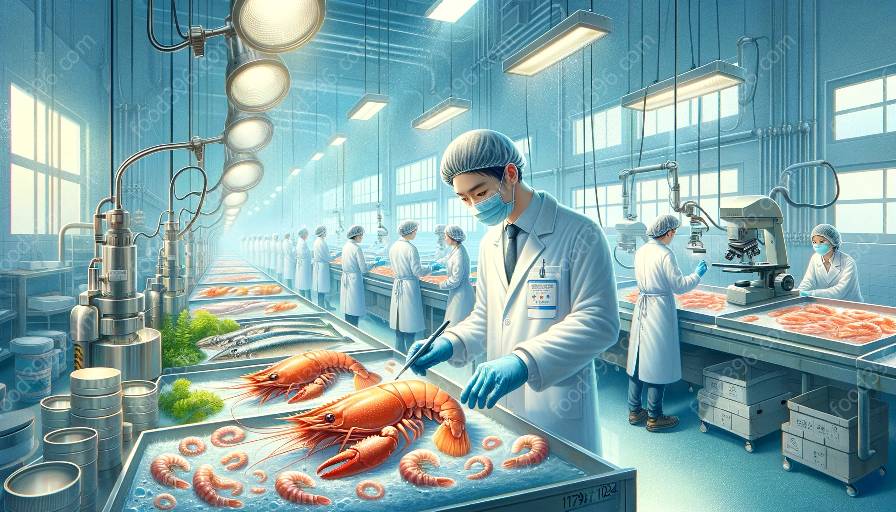Seafood distribution involves a complex network of processes and logistics to ensure that fresh and high-quality products reach the consumers. Among the critical aspects of seafood distribution, cold chain management plays a pivotal role in maintaining the safety, quality, and shelf life of seafood products. In this article, we'll delve into the importance of cold chain management in seafood distribution, how it relates to seafood safety and sanitation, and its connection to seafood science.
The Significance of Cold Chain Management
Seafood is highly perishable and requires specific temperature and handling conditions to maintain its freshness and safety. The cold chain encompasses the entire process of maintaining a consistent, controlled temperature environment from the point of harvest or processing to the point of consumption. This includes storage, transportation, and retail display of seafood products. Any break in the cold chain can lead to the proliferation of bacteria, spoilage, and potential health hazards for consumers.
Effective cold chain management ensures that seafood remains within the optimum temperature range to prevent the growth of pathogens and spoilage microorganisms. By maintaining the cold chain, the quality, flavor, texture, and nutritional value of seafood products can be preserved, offering consumers a desirable and safe eating experience.
Seafood Safety and Sanitation
Cold chain management directly intersects with seafood safety and sanitation. Proper temperature control is a critical factor in preventing microbial contamination and reducing the risk of foodborne illnesses associated with seafood consumption. Temperature abuse, where seafood products are exposed to inappropriate temperatures, can result in the proliferation of pathogenic bacteria such as Salmonella, Listeria, and Vibrio species.
Furthermore, effective cold chain management contributes to maintaining the microbiological and chemical safety of seafood. By controlling temperature and monitoring storage conditions, the potential for histamine formation in certain types of seafood, such as tuna and mackerel, can be minimized, reducing the risk of histamine poisoning.
In addition to temperature control, proper sanitation practices throughout the seafood distribution chain are essential for preventing cross-contamination and ensuring the hygienic handling of seafood products. This includes adherence to good manufacturing practices (GMP) and sanitation standard operating procedures (SSOP) at processing facilities, storage warehouses, transportation vehicles, and retail outlets.
Seafood Science and Cold Chain Management
Seafood science encompasses various disciplines, including food chemistry, microbiology, and technology, that contribute to the understanding of seafood quality, safety, and preservation. Cold chain management aligns with seafood science by integrating principles of food microbiology and biochemistry to maintain the quality and extend the shelf life of seafood products.
Technological advancements in cold chain management, such as temperature monitoring systems, modified atmosphere packaging, and refrigeration equipment, are informed by scientific principles to optimize the storage and transportation of seafood. For example, understanding the metabolic and spoilage processes in different seafood species allows for the development of tailored cold chain strategies to mitigate quality degradation and ensure product safety.
Best Practices in Cold Chain Management
Implementing best practices in cold chain management is essential for ensuring the integrity of seafood products throughout the distribution process:
- Temperature Monitoring: Regular monitoring and recording of temperatures at critical control points, including storage facilities, refrigerated transport vehicles, and retail display cases, are crucial to identifying and addressing any deviations from the desired temperature range.
- Proper Handling and Packaging: Seafood should be handled with care to avoid physical damage and contamination. Utilizing appropriate packaging, such as insulated containers and refrigerated storage units, helps maintain the desired temperature and prolong shelf life.
- Training and Compliance: Training personnel involved in seafood handling and distribution on proper cold chain procedures and hygiene practices is imperative. Compliance with relevant food safety regulations and standards, such as Hazard Analysis and Critical Control Points (HACCP), is essential for ensuring the safety and quality of seafood products.
- Traceability and Quality Assurance: Implementing traceability systems enables the tracking of seafood products throughout the supply chain, facilitating rapid response to any quality or safety issues. Quality assurance protocols, including sensory evaluation and microbial testing, further enhance the control of seafood quality.
Conclusion
Cold chain management is a fundamental aspect of ensuring the safety, quality, and freshness of seafood throughout the distribution process. By aligning with seafood safety, sanitation, and science principles, effective cold chain management minimizes the risk of contamination, preserves the sensory attributes of seafood, and ultimately provides consumers with wholesome and safe products. Embracing best practices and leveraging technological innovations in cold chain management contributes to the sustainability and growth of the seafood industry, meeting the increasing demands for high-quality seafood products.

